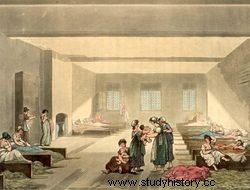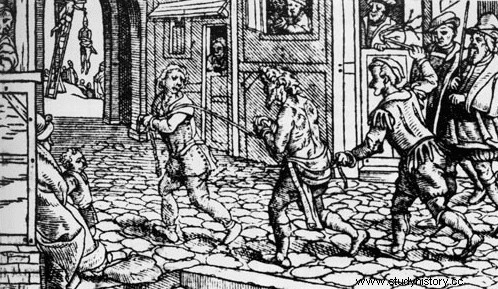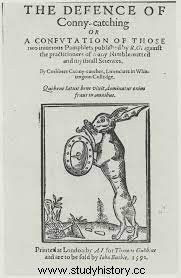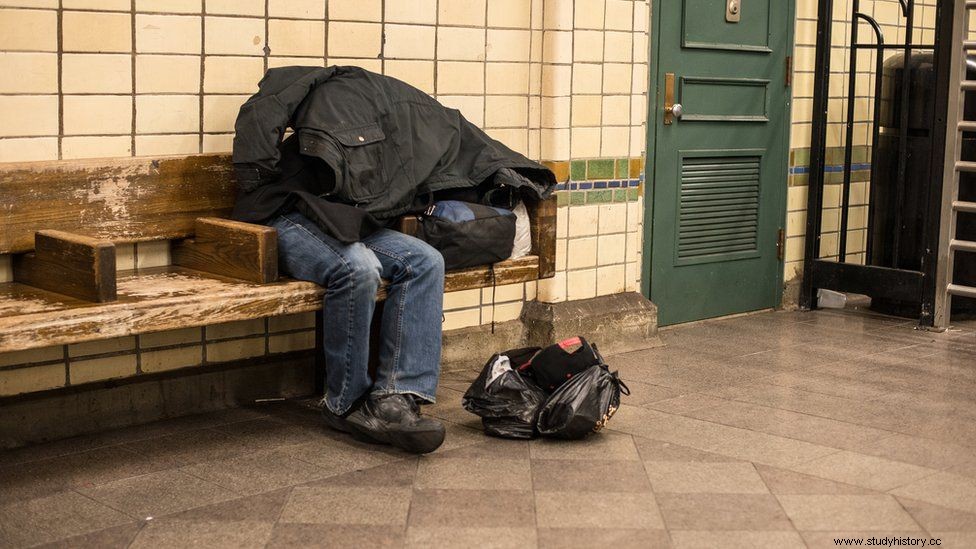Masterless people, poor, tramplers, rogues, rascals, travelers, homeless, walkers, vagabonds and many more marked groups of people or individuals as such. All of these legalized categories refer to the people who are criminalized because of the way they live, not what they do. From the Middle Ages to 20 th century, wanderers or vagabonds were great targets since they posed a threat to social norms and moral order. Through the enactment of laws, known as the Vagrancy Acts, the authorities sought to bring these groups and individuals under control.
Vagabonds referred to unemployed people who wandered aimlessly without a job or salary. These groups included itinerant soldiers, petty criminals, entertainers, and disorderly persons. In other words, non-normative organs and people who walked in an unregulated way were marked as walkers. And they were judged to be the way they were. Although they did not commit any crime, they were treated as part of criminal organizations.
Local authorities, laws and the judiciary were all intimidated by the presence of these people and felt threatened by their existence and aimless walks. Thus, they took a stand against them and targeted them as a socio-political problem, which they tried to solve through punishments, corporal punishment and laws. These laws worked to make them useful citizens instead of solving their problems. Throughout the article I will look at vagrancy through different media. I will focus on law, literature and cinema to see the portrayals of unemployed people in different contexts.

Etymology of Vagrant and Vagrancy:
First, let's start by looking at the origin of the words wandering and non-slip . According to the Oxford etymology dictionary, wandering refers to a "person who lacks ordinary work, one without permanent residence, a tramp", while v agangel comes from the Latin word vagary, which means "walking, strolling around, wandering around, being restless, spreading abroad". It shares the same root word with "vag", which means "walk, walk, walk", figuratively "wobbly, uncertain". This may indicate that the non-crucial condition of unemployed people, which fluctuates between an inhabitant and an outcast, makes them a vague figure in society.
How did vagrancy become such a big issue?
Factors such as war, plague, population growth, poor crops, dissolution of churches, immigration and poverty all played a role. Although poverty was always a problem, in Christianity, Islam and Judaism, it was always a duty to help the poor and give alms. Unfortunately, with the changes in economic conditions, things changed.
I 14 th century, black death was a nightmare in Europe. It increased demand and wages to such a level that the rich would not be able to meet demand. Through the adoption of new laws, farmers were forced to accept lower wages and not to go to the city towns (Ocobock 6). In the beginning, the goal of the laws was to restrict migration and protect the elite.
The second wave of poverty had returned because the population was growing. In addition, there were not enough jobs and wages. In the wake of the Napoleonic Wars, many soldiers returned home, unemployed, without money, so they were put into the same category as the wanderers. As mentioned, the church used to help the poor, give alms as part of the charity system. Unfortunately, the church was no longer able to cope with the growing needs of the poor. Therefore, the whole picture of the management system was changed. New laws were passed. The only help would be given to the deserving poor, which was the new category the government came up with.

Vagrancy Acts
Vagrancy Acts were formed to limit unregulated mobility and put unemployed people under surveillance. They were imposed in different years and changed in time.
1494 Lov:"1494 Action against vagabonds and beggars" stated:
Vagabonds, unemployed and suspects will be put in storage for three days and three nights and have no food other than bread and water and then put out of town. Every beggar who is fit to work should resort to the hundreds where he last lived, is best known, or was born, and there are again pains mentioned above. ”
1531 Law:
According to this action, the penalties were much stricter. The walkers were whipped in the streets. It was a public spectacle to intimidate others. This action also distinguished between the poor poor and the deserving poor. The elderly, sick and disorderly were in the former group and were licensed to beg.
1572 Lov:
The 1572 Act, known as "A Law for the Punishment of Vagabonds and for the Relief of the Poor and Impotent", states:in any part of this kingdom, or wandered and wandered and misbehaved contrary to the purpose of this present law of Parliament. ”
It goes on to say that "the judgment shall at present also be enforced, except for an honest person, valued at the last grant next before that time to £ 5 in goods or 20s in rural areas, or someone as honest a housekeeper as by the judges in peace… should be allowed, his charity will for the moment content itself with taking such offenders… into the service for a whole year afterwards; ... and if such a junk or vagabond used in the said year deviates from the service against the will of the one who takes him or her into service, such a junk or vagabond will be whipped and burned ... as mentioned above. ”
In short, it required that the vagabonds be given as slaves to landowners. They had to work for reliable citizens for at least one year. If they were not obedient, they would be punished and burned through the ear.
The Poor Relief Act 1601 or Elizabethan Poor Law:
With Poverty Aid actions vagrancy was categorized and divided into groups depending on the individual's ability to work. First, it was the poor, who referred to those who could work, but chose not to do so. The second category was the undeservedly poor, which included the disadvantaged, the elderly and the sick. Finally, the third referred to scammers and wanderers with unscrupulous behavior. They were to be sent to a prison or correctional facility.
Other Solutions
Transporting the refugees to the colonies was another solution. In the colonies they got jobs, husbands / wives to become resident citizens. Paul Ocobock states that this was especially practiced by Portugal and England:"In Portugal, criminals, immigrants, orphaned women were rounded up, sentenced to exile and transported to colonies such as Brazil and Goa" (12).
In addition, these laws in the 19th and 20th years are th centuries were transported to the colonial states of Africa and used there as well. The number and diversity of institutions such as hospitals, workhouses and prisons increased.
Rogue literature 
Literary works became complicit in the stigmatization of vacant bodies. They played an important role in the construction of the refugee threat, and the migrants' connection to scammers. At 16 th and 17 th centuries in England, junk literature was very popular. It tells stories about the world of thieves and other criminals, written in scriptural form with lively descriptions of ordinary people's everyday lives. To put it another way, it was a reflection on the Elizabethan underworld. Thomas Harman, Thomas Dekker and Robert Greene were some of the famous authors of junk literature. Greene was especially known for his cone-catching booklets.
John Awdeley's Brotherhood of Vagabonds (1561), Thomas Harman's A Caveat for Common Cursitors vulgarly Called Vagabonds (1566), Thomas Dekker's Lantern and Candle are some examples from junk literature. Modern scholarships accept these representations in the underworld as at least partially fictional (Boecker 99). In Vagrancy, Homelessness and English Renaissance Literature , Linda Woodbridge offers an in-depth analysis of free bodies and their representation in literary works.
Tom o'Bedlam
To the Elizabethans, Tom o'Bedlam was a hoax, a character, or a stereotypical junk brochure that is often referred to. We may encounter this name even in Shakespeare's play. For example, in King Lear, Edgar disguises himself as the crazy Tom o'Bedlam. Thus, it is a term used in early modern Britain to refer to immigrants and beggars who pretended to have mental illness. The background story for this character actually comes from an anonymous poem, whose speaker is a Bedlamite. And Bedlamite refers to someone who lived in a mental hospital called Bedlam in London.
Foucault Discipline and Punish :
In this book, Foucault discusses the play in the body as the corpse of punishment and how punishments are changed through technological monitoring of society. The first part of the novel, which bases the arguments on the body's acting, also applies to those who wander, who were whipped and physically tortured in public. From there, Foucault begins to build his arguments about the birth of the prison, and the new power system acts as a network system.
He also suggests arguments about literary works from the 19th century. However, his view states that literary works actually made heroes of criminals.

Vagabonds in cinematic expression
In addition to literature, the term vagabond is also interpreted with cinematic gaze. Agnes Varda Vagabond and Fellini's The Road are two examples of cinematic reflections of the vagabond.
Vagabond (1985) by avant-garde director Agnes Varda
The documentary-like and experimental style of Agnes Varda, this time, records the journey of a vagabond. The original name of the film, "Sans toit ni loi", translates as neither shelter nor law.The film is based on the interviews with the people who helped the vagabond, gave her a job or a place to live.Her struggle to survive, others' treatment of her as an outcast because she does not really want to do anything, can be the film's biggest worries.
Fellini's The Road (1954)
The Road is another heartbreaking film, which tells the story of Italian walkers, practitioners and disoriented figures. The plot is about a girl named Gelsomina who becomes an apprentice to a circus artist named Zampana. Out of poverty, the mother sells the daughter of this brutal man. She starts working for him and develops a bond, which will eventually drive Gelsomina towards her death. On the journey together, after being kicked out of the circus, they go through difficult times. They seek help from the nuns, who give them food and a place to live.
As an example of Italian neorealism, it is a look at street life, a circus and ordinary people. It's about sharing, whether it's food, shelter or music and entertainment, which either binds or separates the characters.

Vagrancy in today's world
The laws of vaginality are still heavily criticized for not offering a solution other than criminalizing the poor. They are actually trying to make the problem invisible. The streets are still open to many homeless people, and begging and sleeping hard is still a violation. Homeless and rough sleep are unwanted scenes in the streets. The solution is "defensive architecture".
The anti-homeless street architecture is as unwelcome as the laws. Sloping benches, curved benches, solid partitions on benches, sidewalk sprinklers and studs don urban space. Their only function is to prevent the homeless from sleeping in public. This urban planning shows what Foucault can refer to in Discipline and Punish . To be more explicit, the methods of controlling the body have changed shape. There is no more whipping or making the body a public spectacle. For example, in this case, architectural design plays its role in making the inactive body disappear from the streets.
Anti-homeless street architecture as an art project
Anti-homeless architectural design has also had an impact on art projects. For example, Nils Norman, whose interests lie in urban planning and public art, has projects that challenge mainstream urban planning. One of these projects is his photography collection, which documents anti-homeless or defensive urban architecture. These photographs and the reality they show increase social awareness.
Socio-political significance of vagrancy
Vagrancy was a category that legitimized the exclusion of a particular group of people from sympathy or some form of assistance from obedient citizens, the judiciary and the authorities. It was an invented crime of Europe. Vagrants or vagabonds were chosen as scapegoats to prevent residents from living free, to produce functioning citizens.
The corpus of work on loose housing and vagabondage helps us to understand the body on the go as a socio-political context and its exclusion from civil rights when it is not usable for the authorities and society. It is important to understand where these actions come from and how a state of being is challenged. It is still a major problem that requires enormous consideration. Although urban street architecture can try to make them invisible, the problem is still a part of our lives.
References:
Beier, AL, Ocobock, Paul, eds. Cast Out:Vagrancy and Homelessness in a Global and Historical Perspective . Ohio:Ohio University Press, 2008.
Boecker, Bettina. "Falsehood, Fact and Fiction in Early Modern Rogue Literature:Robert Greene's Cony-Catching Pamplets." Poetics , Volume 41, No. 1/2, 2009, pp. 97-125. JSTOR .
Foucault, Michael. Discipline and Punish:The Birth of the Prison . New York:Random House, 1978.
Woodbridge, Linda. Vagrancy, homelessness and English Renaissance literature. Urban:University of Illinois Press, 1945.
